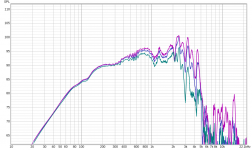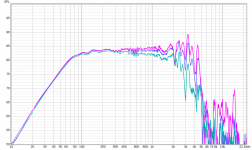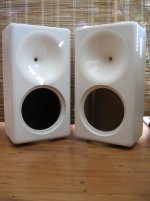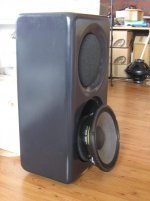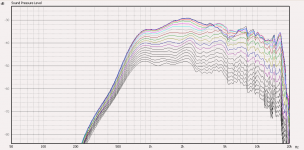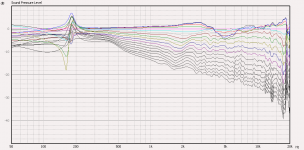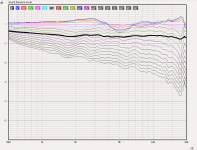It is Deltalite II 2512, right? I had this woofer in my first speakers of this kind but I didn't like the cone and finally got rid of them. Overall it is quite basic driver, not really suitable in a two-way design like this, IMHO. I bought them because I wanted to save some money at that time but I should have put more money in a better woofer right at the start.
Last edited:
I didn't like the cone [...] Overall it is quite basic driver, not really suitable in a two-way design like this, IMHO.
Care to be more specific? In my measurements it has good directivity behavior to ~2kHz and low harmonic distortion.
It was around 10 years ago, I don't have the data anymore and I only remember I was dissapointed - the cone had plenty of quite strong resonances just above the intended crossover point that were difficult to suppress. It didn't sound as transparent as some other drivers with heavier and better damped cones. That said, I'm sure your speakers play far better than most. In absolute terms they are still awesome!
Last edited:
Fair enough. I actually bought the woofers (and compression drivers) years before I built those speakers, so I didn't have a choice without spending more money 🙂. I'm doing the crossover in the digital domain and have as many parametric filters as I could possibly need at my disposal, so frequency response issues are not a problem; only directivity problems matter.
I've attached some ground plane data of the woofer in the cabinet. The first graph is the raw response and the second is with a bit of EQ. Angles are approx. 0, 15, and 30 degrees (I'm pretty sure I did a couple more measurements further off axis, but I guess I didn't save them).
I've attached some ground plane data of the woofer in the cabinet. The first graph is the raw response and the second is with a bit of EQ. Angles are approx. 0, 15, and 30 degrees (I'm pretty sure I did a couple more measurements further off axis, but I guess I didn't save them).
Attachments
I tried to find the data but found only some photos - phew, already 10 years. I think these could well be the first DIY OS waveguides in Europe at that time - basically all done based on "Geddes on Waveguides" thread 🙂 If I remember correctly, these were the waveguides that Jacek and Autotech later used in their "Mummy" speakers. As you can imagine, these were still not well terminated - done completely blind at the time.
Attachments
Does anyone know of any research investigating DI slope and listener preference? It's well established that the DI should be smooth, but I've not seen anything comparing, for example, smoothly increasing DI vs flat DI.
Probably theses studies are related somehow to your question ?!
Effects of Loudspeaker Directivity on Perceived Sound Quality - A Review of Existing Studies
AES E-Library >> Effects of Loudspeaker Directivity on Perceived Sound Quality - A Review of Existing Studies
Listening Tests for the Effect of Loudspeaker Directivity and Positioning on Auditory Scene Perception
AES Convention Papers Forum >> Listening Tests for the Effect of Loudspeaker Directivity and Positioning on Auditory Scene Perception
I would look at Faital 15PR400 for a matching driver. Troels G built a project with these.

It looks really well behaved in the x-over regeion compared to the Deltalites.
//

It looks really well behaved in the x-over regeion compared to the Deltalites.
//
I wouldn't choose those either. The same flimsy cone, I'm afraid, but it seems everyone has to go through this him/herself.
I don't want to go into this (again), so only shortly - I don't know what I would buy today, I haven't looked around for a while but I have two drivers from the past that I'm still quite happy with: 18Sound 12LW1400 (which replaced the Deltalites) and 15W930. B&C TBX line is also exceptional, just look at what drivers Earl Geddes used. There are plenty of good drivers with well damped cones and elaborated motors, but there still seems to be this myth about the need of a lightweight cones to reproduce the midrange properly. And in fact, it's almost on the contrary...
This one is different from the DE7, right? Makes me want to print one for a 1" driver, too. The Beyma CP385Nd or a DE500 should work fine in one. As large as possible, limited only by 30x30 cm bed."Rapid" prototyping in DIY praxis..... Ready to measure the small one with DE360.
Thanks to Mabat once more.
Yes, that one is a 1" throat version. As pet007 is already a trusted part of the "development team", he has it first hand. Anyone willing to participate in testing the waveguides with various drivers is welcome. I can provide the models, you would have to make it real and show the results 🙂
Last edited:
There's a wealth of info here for the practical comparison of very detailed measurements to Toole's findings:Does anyone know of any research investigating DI slope and listener preference? It's well established that the DI should be smooth, but I've not seen anything comparing, for example, smoothly increasing DI vs flat DI.
Speaker Reviews, Measurements and Discussion | Audio Science Review (ASR) Forum
Wow, these are the most impressive images I've seen in a long time (post #3): Dynaudio X14 Speaker Review | Audio Science Review (ASR) Forum
Tagged with Jupiter - Dynaudio
Dynaudio Labs Jupiter Measurement Room - YouTube
- I guess I need a break.
Tagged with Jupiter - Dynaudio
Dynaudio Labs Jupiter Measurement Room - YouTube
- I guess I need a break.
Last edited:
Probably theses studies are related somehow to your question ?!
Effects of Loudspeaker Directivity on Perceived Sound Quality - A Review of Existing Studies
AES E-Library >> Effects of Loudspeaker Directivity on Perceived Sound Quality - A Review of Existing Studies
Listening Tests for the Effect of Loudspeaker Directivity and Positioning on Auditory Scene Perception
AES Convention Papers Forum >> Listening Tests for the Effect of Loudspeaker Directivity and Positioning on Auditory Scene Perception
Thanks, I'm not an AES member, but I was able to look through the first one since it's freely available (just copy and paste the title into your favorite search engine). Unless significant research has been done since its publication, it confirms that there just isn't enough data available to answer my particular question.
There's a wealth of info here for the practical comparison of very detailed measurements to Toole's findings:
Speaker Reviews, Measurements and Discussion | Audio Science Review (ASR) Forum
There's lots of good measurements there, but those don't really answer the listener preference question. Olive's prediction algorithm, while useful, isn't a direct replacement for properly done blind listening tests.
Finally I found at least some measurements of the waveguide with DE250
Definitely illustrates the influence of the termination (especially near the axis). My waveguide is roughly ±1dB on axis relative to the listening axis, while that one is +3/-4dB. Your recent designs seem to be within +1/-0dB with basically no discernible ripple.
There's lots of good measurements there, but those don't really answer the listener preference question. Olive's prediction algorithm, while useful, isn't a direct replacement for properly done blind listening tests.
But his algorithm is based on "properly done blind listening tests" which included listener preference. So it is a good substitute for same.
My statement was worded poorly. What you said is true generally of course, but the algorithm doesn't address the exact quality I was wondering about:
The preference rating uses the "smoothness" of the predicted in-room response, but doesn't care about the slope nor the exact shape.Does anyone know of any research investigating DI slope and listener preference? It's well established that the DI should be smooth, but I've not seen anything comparing, for example, smoothly increasing DI vs flat DI.
For my money, it should be fairly flat, smooth, as high in level and as low in frequency as practicable, with a slightly fally listening axis response. There are lots of reasons to support this, but that is another topic.
- Home
- Loudspeakers
- Multi-Way
- Acoustic Horn Design – The Easy Way (Ath4)
